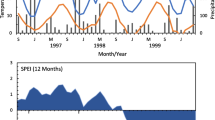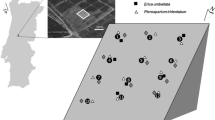Abstract
Postfire vegetation regeneration in many fire-prone ecosystems is soil seed bank dependent. Although vegetation and seed bank may be spatially structured, the role of prefire vegetation patterns and fire in determining postfire vegetation patterns is poorly known. Here, we investigated the spatial patterning of species abundance and richness in the vegetation and seed bank of a Mediterranean encroached dehesa in Central Spain. The seed bank was studied with and without a heat shock simulating a spatially homogeneous fire. Semivariograms and cross-semivariograms showed that species richness in the vegetation was aggregated in patches, mainly of herbs, with highest values corresponding to high herb cover and low tree cover. Species richness in the seed bank was also structured in patches, but the spatial pattern was weak. Seedling density of germinates in the seed bank also showed weak spatial pattern. Heating increased overall germination and species richness, and the intensity of the spatial pattern of species richness, particularly of herbaceous species. However, seed bank density patterns disappeared after heat shock because of increased germination of shrubs without spatial pattern. Our results document that the spatial structure of plant richness in the vegetation may persist after fire due to the spatial patterns of herbaceous species in the seed bank, and that postfire species richness patterns can arise independently of fire intensity patterns. However, the spatial structure of the vegetation after fire can be altered by the feedback between shrub encroachment and an eventual fire because of the ubiquitous germination of shrubs.



Similar content being viewed by others
References
Acácio V, Holmgren M, Rego F, Moreira F, Mohren GMJ (2009) Are drought and wildfires turning Mediterranean cork oak forests into persistent shrublands? Agrofor Syst 76(2):389–400
Aguiar MR, Sala OE (1999) Patch structure, dynamics and implications for the functioning of arid ecosystems. Trends Ecol Evol 14(7):273–277
Bigwood DW, Inouye DW (1988) Spatial pattern-analysis of seed banks—an improved method and optimized sampling. Ecology 69(2):497–507
Bond WJ, van Wilgen BW (1996) Fire and plants. Chapman and Hall, London
Bossuyt B, Honnay O (2008) Heat shock increases the reliability of a temperate calcareous grassland seed bank study. Plant Ecol 199(1):1–7
Breshears DD (2006) The grassland-forest continuum: trends in ecosystem properties for woody plant mosaics? Front Ecol Environ 4(2):96–104
Brudvig LA, Asbjornsen H (2009) The removal of woody encroachment restores biophysical gradients in Midwestern oak savannas. J Appl Ecol 46(1):231–240
Bugalho MN, Caldeira MC, Pereira JS, Aronson J, Pausas JG (2011) Mediterranean cork oak savannas require human use to sustain biodiversity and ecosystem services. Front Ecol Environ 9(5):278–286
Caballero I, Olano JM, Loidi J, Escudero A (2008) A model for small-scale seed bank and standing vegetation connection along time. Oikos 117(12):1788–1795
Céspedes B, Torres I, Luna B, Pérez B, Moreno JM (2012) Soil seed bank, fire season, and temporal patterns of germination in a seeder-dominated Mediterranean shrubland. Plant Ecol 213:383–393
Davis FW, Borchert MI, Odion DC (1989) Establishment of microscale vegetation pattern in maritime chaparral after fire. Vegetatio 84(1):53–67
Duguy B, Alloza JA, Röder A, Vallejo R, Pastor F (2007) Modelling the effects of landscape fuel treatments on fire growth and behaviour in a Mediterranean landscape (eastern Spain). Int J Wildland Fire 16(5):619–632
Figueroa JA, Teillier S, Jaksic FM (2004) Composition, size and dynamics of the seed bank in a mediterranean shrubland of Chile. Austral Ecol 29(5):574–584
González Bernáldez F, Morey M, Velasco F (1969) Influences of Quercus ilex rotundifolia on the herb layer at the El Pardo forest (Madrid). Bol Real Soc Esp Hist Nat (Biología) 67:265–284
Henderson CB, Petersen KE, Redak RA (1988) Spatial and temporal patterns in the seed bank and vegetation of a desert grassland community. J Ecol 76(3):717–728
Hiers JK, O’Brien JJ, Mitchell RJ, Grego JM, Loudermilk LE (2009) The wildland fuel cell concept: an approach to characterize fine-scale variation in fuels and fire in frequently burned longleaf pine forests. Int J Wildland Fire 18:315–325
Isaaks EH, Srivastava RM (1989) An introduction to applied geostatistics. Oxford University Press, New York
Izhaki I, Henig-Sever N, Ne’eman G (2000) Soil seed banks in Mediterranean Aleppo pine forests: the effect of heat, cover and ash on seedling emergence. J Ecol 88(4):667–675
Keeley JE (1991) Seed-germination and life-history syndromes in the California chaparral. Bot Rev 57(2):81–116
Keeley JE, Fotheringham CJ, Baer-Keeley M (2005) Factors affecting plant diversity during post-fire recovery and succession of mediterranean-climate shrublands in California, USA. Divers Distrib 11(6):525–537
Keeley JE, Brennan T, Pfaff AH (2008) Fire severity and ecosystem responses following crown fires in California shrublands. Ecol Appl 18(6):1530–1546
Kutiel P (1997) Spatial and temporal heterogeneity of species diversity in a Mediterranean ecosystem following fire. Int J Wildland Fire 7(4):307–315
Lavorel S, Lebreton JD, Debussche M, Lepart J (1991) Nested spatial patterns in seed bank and vegetation of Mediterranean old-fields. J Veg Sci 2(3):367–376
Legendre P, Fortin MJ (1989) Spatial pattern and ecological analysis. Vegetatio 80(2):107–138
Legendre P, Mi X, Ren H, Ma K, Yu M, Sun IF, He F (2009) Partitioning beta diversity in a subtropical broad-leaved forest of China. Ecology 90(3):663–674
López-Pintor A, Espigares T, Benayas JMR (2003) Spatial segregation of plant species caused by Retama sphaerocarpa influence in a Mediterranean pasture: a perspective from the soil seed bank. Plant Ecol 167(1):107–116
Ludwig JA, Wilcox BP, Breshears DD, Tongway DJ, Imeson AC (2005) Vegetation patches and runoff-erosion as interacting ecohydrological processes in semiarid landscapes. Ecology 86(2):288–297
Maltez-Mouro S, García LV, Marañón T, Freitas H (2005) The combined role of topography and overstorey tree composition in promoting edaphic and floristic variation in a Mediterranean forest. Ecol Res 20:668–677
Marañón T, Pugnaire FI, Callaway RM (2009) Mediterranean-climate oak savannas: the interplay between abiotic environment and species interactions. Web Ecol 9:30–43
Miller BP, Perry GLW, Enright NJ, Lamont BB (2010) Contrasting spatial pattern and pattern-forming processes in natural vs. restored shrublands. J Appl Ecol 47(3):701–709
Moreno JM, Oechel WC (1991) Fire intensity effects on germination of shrubs and herbs in Southern California chaparral. Ecology 72(6):1993–2004
Moreno JM, Vázquez A, Vélez R (1998) Recent history of forest fires in Spain. In: Moreno JM (ed) Large forest fires. Backhuys Publishers, Leiden, pp 159–185
Moreno JM, Zuazua E, Pérez B, Luna B, Velasco A, Resco de Dios V (2011) Rainfall patterns after fire differentially affect the recruitment of three Mediterranean shrubs. Biogeosciences 8:3721–3732
Moreno JM, Torres I, Luna B, Oechel WC, Keeley JE (2012) Changes in fire intensity have carry-over effects on plant responses after the next fire in southern California chaparral. Journal of Vegetation Science. doi: 10.1111/j.1654-1103.2012.01466.x
Odion DC, Davis FW (2000) Fire, soil heating, and the formation of vegetation patterns in chaparral. Ecol Monogr 70(1):149–169
Olano JM, Caballero I, Laskurain NA, Loidi J, Escudero A (2002) Seed bank spatial pattern in a temperate secondary forest. J Veg Sci 13(6):775–784
Ooi MKJ, Whelan RJ, Auld TD (2006) Persistence of obligate-seeding species at the population scale: effects of fire intensity, fire patchiness and long fire-free intervals. Int J Wildland Fire 15(2):261–269
Ortega M, Levassor C, Peco B (1997) Seasonal dynamics of Mediterranean pasture seed banks along environmental gradients. J Biogeogr 24(2):177–195
Pausas JG, Bradstock RA, Keith DA, Keeley JE (2004) Plant functional traits in relation to fire in crown-fire ecosystems. Ecology 85(4):1085–1100
Pebesma E (2003) gstat. Geostatistical modelling, prediction and simulation
Pérez B, Cruz A, Fernández-Gonzalez F, Moreno JM (2003) Effects of the recent land-use history on the postfire vegetation of uplands in Central Spain. For Ecol Manage 182:273–283
Perry GLW, Enright NJ, Miller BP, Lamont BB (2008) Spatial patterns in species-rich sclerophyll shrublands of southwestern Australia. J Veg Sci 19(5):705–716
R Development Core Team (2010) R: a language and environment for statistical computing. R Foundation for Statistical Computing, Vienna
Robertson GP, Gross KL (1994) Assessing the heterogeneity of belowground resources: quantifying pattern and scale. In: Caldwell MM, Pearcy RW (eds) Exploitation of environmental heterogeneity by plants: ecophysiological processes above- and belowground. Academic Press, San Diego, pp 237–253
Rossi RE, Mulla DJ, Journel AG, Franz EH (1992) Geostatistical tools for modeling and interpreting ecological spatial dependence. Ecol Monogr 62(2):277–314
Scott K, Setterfield S, Douglas M, Andersen A (2010) Soil seed banks confer resilience to savanna grass-layer plants during seasonal disturbance. Acta Oecol 36(2):202–210
Segura AM, Holmgren M, Anabalon JJ, Fuentes ER (1998) The significance of fire intensity in creating local patchiness in the Chilean matorral. Plant Ecol 139(2):259–264
Shachak M, Boeken B, Groner E, Kadmon R, Lubin Y, Meron E, Ne’Eman G, Perevolotsky A, Shkedy Y, Ungar ED (2008) Woody species as landscape modulators and their effect on biodiversity patterns. Bioscience 58(3):209–221
Stark KE, Arsenault A, Bradfield GE (2008) Variation in soil seed bank species composition of a dry coniferous forest: spatial scale and sampling considerations. Plant Ecol 197(2):173–181
Thompson K, Bakker J, Bekker R (1997) The soil seed banks of North West Europe: methodology, density and strategies for sampling. Cambridge University Press, Cambridge
Torres I, Urbieta IR, Moreno JM (2012) Vegetation and soil seed bank relationships across microhabitats in an abandoned Quercus suber parkland under simulated fire. Ecoscience 19(1):1–10
Valbuena L, Trabaud L (2001) Contribution of the soil seed bank to post-fire recovery of a heathland. Plant Ecol 152(2):175–183
Acknowledgments
The authors are thankful to J. M. Torrego for permission to work in the field site. A. Velasco provided valuable help at the greenhouse. G. Perry and two anonymous reviewers made valuable comments that helped to improve this manuscript. This project benefitted from funding by the EC FUME project (GA 243888). I. Torres was supported by a FPU grant from the Spanish Ministry of Education and Science (AP 2003-1440).
Author information
Authors and Affiliations
Corresponding author
Electronic supplementary material
Below is the link to the electronic supplementary material.
Rights and permissions
About this article
Cite this article
Torres, I., Céspedes, B., Pérez, B. et al. Spatial relationships between the standing vegetation and the soil seed bank in a fire-prone encroached dehesa in Central Spain. Plant Ecol 214, 195–206 (2013). https://doi.org/10.1007/s11258-012-0159-5
Received:
Accepted:
Published:
Issue Date:
DOI: https://doi.org/10.1007/s11258-012-0159-5




